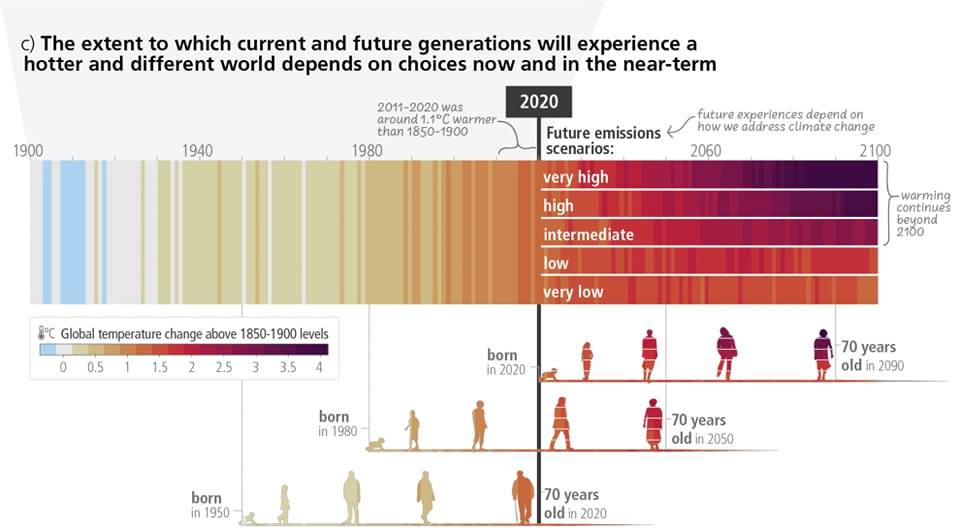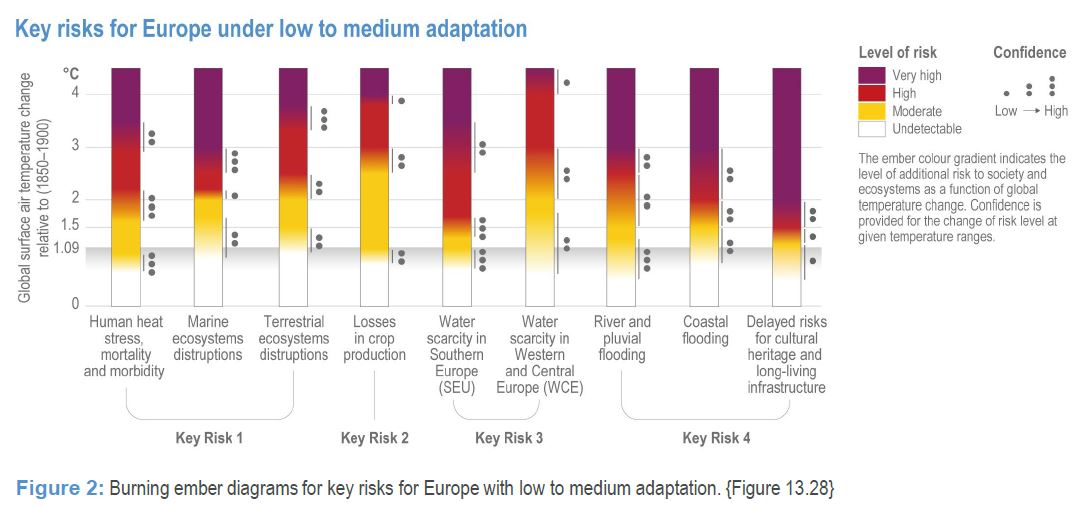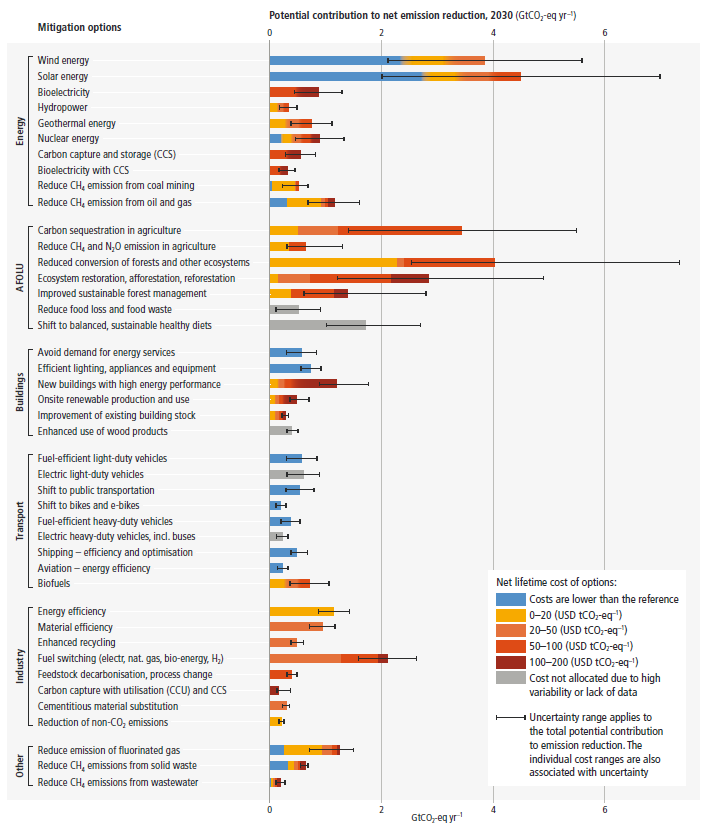IPCC Synthesis Report: every fraction of a degree matters

“The options for reducing greenhouse gas emissions and adapt to human-caused climatic changes are within reach, feasible, and effective, and are available now.” This is the key message of the last IPCC (Intergovernmental Panel on Climate Change) Synthesis Report published on March 20, 2023. This report represents the final, comprehensive summary of the Sixth Assessment Report (AR6), consisting of three documents released between 2021 and 2022. The first document (WG1) summarises the most advanced scientific knowledge on climate change. The second (WG2) lists the impacts of climate change, linking them to social and environmental vulnerabilities, and provides a view on planning adaptation measures. The third document (WG3) analyses the available mitigation solutions and identifies the most advantageous ones.
The recently published synthesis report reiterates the most salient messages of each of these documents and urges policymakers, companies, and society at large to act swiftly, because solutions exist, but the time for action is rapidly closing.
“From reading the reports, three emotions stand out: severity, urgency, but also hope,” says Lucia Perugini, a researcher at the Euro-Mediterranean Centre on Climate Change (CMCC), IPCC focal point for Italy, during the Italian presentation of the report organised by the CMCC.
“The severity of the threat is related to the fact that many ecosystems will not be able to adapt to a climate warmer than 1,5°C. The sense of urgency comes from the inadequacy of commitments post the Paris Agreement. There is the looming threat of hitting 3,5°C by 2100, whereas we should peak emissions by 2025 and then halve them by 2030. But there is also hope, because there is still room for improvement: many solutions are available and all need to be implemented. But investments must increase from 3 to 6 times”.
Established in 1988 by the World Meteorological Organization and UNEP (United Nations Environment Programme), IPCC does not directly conduct research but reviews and synthesises existing scientific information. It is described as a work of ‘meta-analysis,’ and is considered the best synthesis of scientific consensus on climate change available.
The first IPCC Assessment Report was released in 1990 and served as the basis for UNFCCC, the UN Framework Convention on Climate Change. It is updated approximately every six years. The fifth report, issued in 2014, provided the scientific basis for the 2015 Paris Agreement. The sixth assessment report, published between 2021 and 2022, involved not only almost 800 scientists but also national governments, whose delegates contributed at revising the document aimed at policymakers (Summary for Policymakers). “That part is negotiable, but the science underlying it is not,” Lucia Perugini remarks.
The scientific insights on climate change contained in the first document of the Sixth Assessment Report (AR6 WG1) state that global warming is unequivocally driven by human-made greenhouse gas emissions, primarily stemming from the energy production system reliant on fossil fuels such as gas, oil, and coal. They highlight that the Earth’s temperature has already increased by 1,1°C since the pre-industrial period. “By the early 2030s, we will likely have already reached 1,5°C of global warming,” warns Anna Pirani, a climatologist at Ca’ Foscari University in Venice and one of the authors of the IPCC AR6 WG1 document. “A child born in 2020 will witness far more extreme weather events in their lifetime compared to their grandparents.”

Rapporto di sintesi IPCC AR6, 20 marzo 2023
For the Mediterranean region, things could be worse than in other areas. Climate change will lead to increased precipitation on a global scale, but some regions will experience an opposite trend. “In the Mediterranean area, temperatures are already at 1,5°C, higher than the global average,” argues Piero Lionello, professor of atmospheric physics and oceanography at the University of Salento and one of the authors of the AR6 WG2. “The region will become drier due to reduced rainfall and soil transpiration. Extreme precipitation events, on the other hand, will increase, as will sea levels.”
Global warming has already impacted marine and terrestrial ecosystems, fisheries, and aquaculture, it has increased the occurrence of urban heatwaves and created conditions conducive to wildfires. “The IPCC has identified four categories of risk for the Mediterranean region: more heatwaves (both on land and in the sea), reduced agricultural production, scarce water resources, and increased coastal, river, and rainfall floodings.”
Climate scientists use the so-called “burning ember diagram” to visualise these risks. “Each system reaches critical risk levels at different degrees of warming”, Lionello explains. “For instance, marine ecosystems experience heightened risk at lower warming levels compared to other ecosystems, indicating their higher vulnerability to climate change.”

Grafico a tizzoni ardenti. AR6 WG2, impatto del cambiamento climatico sull'Europa
“Mediterranean tidal waves are usually considered negligible compared to those in other seas. This circumstance has favoured the construction of settlements and infrastructures close to the sea level. However, any rise in sea levels amplifies vulnerabilities,” Lionello continues. “The northern Adriatic region is particularly prone to these vulnerabilities due to its sandy, low-lying coasts, which are heavily populated with settlements. This will influence the tourism sector. For the sake of mitigation efforts, industries like air travel and cruises might face substantial setbacks.”
At a warming of 3°C, more than 50% of insects and plants in Europe will not be able to adapt anymore. Alpine glaciers are already receding, marking the start of a gradual decline that, even if mitigated, may lead to the conservation of only 30% of the current extension of glaciers by the end of the century, in an optimistic projection. “Without a substantial reduction in emissions, alpine glaciers will almost entirely disappear by the end of this century.” This will significantly reduce water availability, posing a risk to cereal production in Europe, which heavily relies on it.
Yet, emissions are still on the rise: in 2019, they almost hit 60 billion tons of CO2eq, marking a 12% increase compared to 2010, and a 54% rise from 1990 levels. The existing policies implemented by national governments fall short in curbing emissions and, instead, are projected to result in a global temperature increase ranging between 2,2 and 3,5°C by the end of the century.

Rapporto di sintesi IPCC AR6, 20 marzo 2023
“However, climate action is increasing,” states Elena Verdolini, CMCC senior scientist and professor of political economy at the University of Brescia, also among the authors of the AR6 WG3. “Over 800 cities and more than 100 regions have pledged for net-zero emission goals. Many technologies and behavioural solutions are available across all sectors to reduce emissions.”
The IPCC report outlines several possible synergies between the available solutions. “Staying below 2°C of warming can be achieved by betting on Carbon Capture and Storage (CCS) technologies, which however are still under study and not currently available. We can also invest on renewable energy sources, which are both accessible and economically viable. Another possible pathway is significantly reducing our energy demand.”
A combination of various solutions will probably be necessary, yet individual behavioural choices will also matter: “Nobody expects that top-down solutions like CCS or solar-shielding geoengineering will solve all problems.” Strong policy decisions will be crucial: “Price regulatory tools have proven effective in limiting emissions, but they need to be coordinated with other economic policies,” Elena Verdolini argues.
The third document of the Sixth IPCC Assessment Report includes a list of potential technological solutions: “Those marked in blue are the most economically feasible solutions, while the red ones indicate higher costs. The length of the bar represents the potential emissions reduction for each solution. For example, solar and wind energy have the capacity to halve emissions by 2030 at a reasonable cost.”

Figura SPM7, Rapporto 2022 IPCC AR6, WG3: valutazione di efficacia e costi delle soluzioni tecnologiche alla mitigazione
“However, more investments in green technologies are needed: there is enough capital available, but it is being directed towards unsustainable solutions such as public subsidies for fossil fuels.”
According to Verdolini, the key message is that every fraction of a degree matters: “Any reduction in emissions is of utmost importance. It is not as if beyond 1,5°C any other outcome is equal. It isn’t. Every reduction by a tenth of degree counts.”
A clear example of this is the survival of coral reefs: “Their capacity to adapt reaches zero beyond 4-5°C,” Leonelli explains. “Taking action now could bring about the change that is needed for a sustainable and just world.”
This article was translated into English by Sofia Belardinelli. The original version of this article is available here.
ALSO READ









